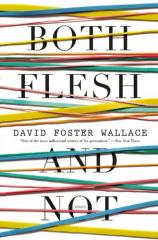Both Flesh and Not: Essays
Review
Both Flesh and Not: Essays
In his 2012 essay collection FARTHER AWAY, Jonathan Franzen devotes two pieces to his relationship with David Foster Wallace, “a friendship of compare and contrast and (in a brotherly way) compete,” as he described it. For Franzen, as he put it in remarks delivered at Wallace’s memorial service in 2008, it was “such a great happiness and privilege and endlessly interesting challenge to be Dave’s friend.” For readers who never had the privilege (or endured the pain) of being Wallace’s friend, BOTH FLESH AND NOT, a diverse, stimulating, occasionally irritating volume of 15 previously uncollected essays, reviews and works of reportage published between 1988 and 2007, will have to suffice.
The common denominator of this wildly varied assortment of pieces is the way they showcase Wallace’s fierce intellect and the quicksilver quality of his dazzling prose, writing that features his trademark footnotes (and occasionally footnotes within footnotes). Whether he’s writing about sports, books, philosophy or film, there’s never any doubt he’s the smartest guy in the room, and yet his earnestness usually tempers any feeling he’s simply showing off.
Wallace was an accomplished junior tennis player, and two absorbing pieces of journalism focus on his favorite sport. The first is a profile of Roger Federer at the peak of his domination of the game at Wimbledon in 2006. “Beauty is not the goal of competitive sports,” Wallace writes, “but high-level sports are a prime venue for the expression of human beauty.” His portrait of Labor Day weekend at the 1996 United States Open --- contrasting the tennis, whose “artistry and energy are bounded by specific lines on the court,” with the “beauty of the commerce” that’s “un- and never bounded” --- is nearly cinematic in its deployment of telling detail.
"The common denominator of this wildly varied assortment of pieces is the way they showcase Wallace’s fierce intellect and the quicksilver quality of his dazzling prose, writing that features his trademark footnotes (and occasionally footnotes within footnotes)."
There are several essays on literary topics, including one containing keen observations on the work of some of his contemporaries, the “Conspicuously Young,” like Jay McInerney and Bret Easton Ellis (“We, though, are Watergate’s children, television’s audience, Reagan’s draft pool, and everyone’s market.”) that elides into a critique of graduate creative writing programs. Wallace offers what he calls an “indexical review” of a collection of 204 prose poems, only about 15 percent of which he concludes are “good/alive/powerful/interesting enough to persist in reader’s mind more than 60 seconds after completion.” In his introduction to the 2007 edition of BEST AMERICAN ESSAYS, he expresses his admiration for “clarity, precision, plainness, lucidity, and the sort of magical compression that enriches instead of vitiates,” though there are times when his own writing displays those qualities only unevenly.
All but the most indulgent readers may find themselves drifting away in the midst of a dense essay like his appreciation of David Markson’s novel WITTGENSTEIN’S MISTRESS, a work he calls a “whispering classic,” placing it on the list he titles “Overlooked: Five Direly Underappreciated U.S. Novels > 1960.” In a similar vein is “Rhetoric and the Math Melodrama,” a 2000 review for Science magazine discussing two obscure novels that “revolve round their protagonists’ quests to solve famous and long-standing number-theoretic problems.” Wallace’s formulation of something he calls the “Inverse Cost and Quality Law,” positing that the larger a movie’s budget the worse (his word is much stronger) the movie will be, may make sense when applied to his consideration of James Cameron’s Terminator 2: Judgment Day, but is belied by the same director’s Avatar. Whether it’s the complexity of Wallace’s arguments or merely their subject matter, these pieces don’t measure up to their companions.
According to a note from Wallace’s publisher, “one of the great thrills of Wallace’s life” was the invitation to serve on the Usage Panel of THE AMERICAN HERITAGE DICTIONARY. In a tribute to what it calls his “insatiable love for words and their meanings,” leading off each essay is a selection from a list of words and their meanings Wallace kept on his computer and constantly updated. From this list we can learn words from “anfractous” or “ylang-ylang” (no “z” words, sorry). A word lover, but no pedant, Wallace’s essays are studded with words like “agnate” and “cingulum” that may drive the lexicographically-challenged to a dictionary or start them compiling their own lists. The essay “24 Word Notes” highlights some of his pet grammatical and usage peeves in a good-humored (and useful) discussion.
“Genius is not replicable,” David Foster Wallace wrote of his tennis idol Roger Federer. As these wide-ranging essays illustrate, both in their singularity of subject matter and the uniqueness of their expression, that label just as easily could have been attached to their author.
Reviewed by Harvey Freedenberg on November 21, 2012
Both Flesh and Not: Essays
- Publication Date: November 19, 2013
- Genres: Essays, Nonfiction
- Paperback: 336 pages
- Publisher: Back Bay Books
- ISBN-10: 0316182389
- ISBN-13: 9780316182386





